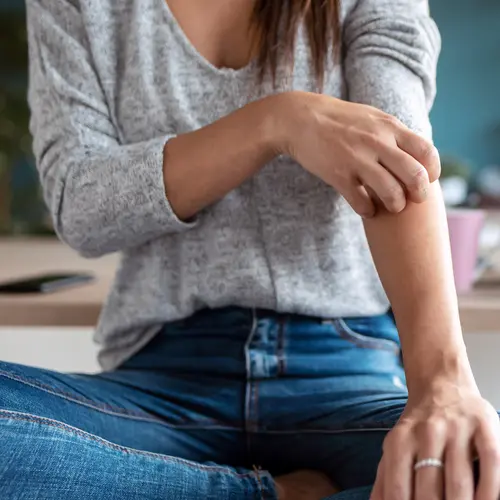Inverse psoriasis is a skin condition that affects the folds of your skin.
Symptoms of Inverse Psoriasis
If you have inverse psoriasis, you’ll notice red, shiny patches in certain places, like:
- Your armpits
- The skin folds around your genitals and between your buttocks
- Under your breasts
- Your groin
The skin in these areas is more sensitive, so the condition is often a challenge to manage and treat. Lesions can cause cracks (called fissures) in the creases of your skin, which may be painful and bleed. Because of its location, the disease may also cause:
- Irritation from rubbing and sweating
- Yeast, fungal, and bacterial infections
- Sexual problems because of discomfort
Get tips on how to treat deep cracks and protect your skin.
Cause and Risk Factors of Inverse Psoriasis
Doctors aren’t sure what causes psoriasis, but they know that your genes and your immune system play a major role. About 40% of people with psoriasis have at least one close relative with the disease. Many of the genes linked to psoriasis are those that help run your immune system.
In addition to your genes, these things can make you more likely to get psoriasis:
- Smoking
- Obesity
- Medications
- Infections
- Alcohol
- Vitamin D deficiency
- Stress
- Skin irritation or any injury to the skin
Treatments and Remedies for Inverse Psoriasis
Many options are available. You can work with your doctor to find one that works best for you.
- Corticosteroids. These medicines can come in forms called topicals that you put on your skin, like creams, lotions, oils, sprays, foams, gels, and ointments. They target the inflammation related to psoriasis. Doctors often prescribe them first. But be careful not to use too much of them, especially stronger ones. Overuse can lead to stretch marks or make the thin skin in these areas even thinner. Follow your doctor’s instructions.
- It’s also not a good idea to cover these areas with plastic bandages since they trap moisture. If you have a yeast or fungal infection, your doctor may prescribe a medication to treat that, mixed with the corticosteroid.
- Dovonex. This drug slows the growth of skin cells and reduces inflammation. It may make your skin sting or burn. If it does, talk to your doctor.
- Pimecrolimus (Elidel) cream and tacrolimus (Protopic) ointment. The FDA approved these drugs to treat eczema, another skin condition. Some dermatologists say they work well for treating inverse psoriasis, too. But talk to your doctor before using them. The FDA warns people to use these medicines only for a short time because some studies suggest they may be linked to slight cancer risks.
- Castellani's paint (Castederm). This product is "painted" onto your skin to dry the moist psoriasis lesions in skin folds. Doctors prescribe it when they think you also have a bacterial or fungal infection. If you need to keep moist areas dry, you can also try baby powder, baking soda, and zinc oxide powder.
- Other topical medications. Treatments such as anthralin and coal tar can irritate skin folds. Your doctor may recommend diluting the creams with a moisturizer, or you can apply them for a short time and then wash them off. You can use these products alone or with a topical corticosteroid, but talk to your doctor about the best approach. Other creams include roflumilast (Zoryve), tapinarof (Vtama), and tazarotene (Tazorac), although the latter can be very irritating in sensitive skin fold areas.
- Phototherapy. Ultraviolet (UV) light therapy works well for many types of psoriasis. Since inverse psoriasis affects areas that are hard to reach, you may need to go to the doctor's office to have this treatment.
- Biologic medications. Biologic medicines are made from living cells and target specific parts of your immune system that play a role in psoriasis. You’ll get these drugs as a shot or an IV. Examples are:
TNF alpha inhibitors
- Adalimumab (Humira)
- Adalimumab-adbm (Cyltezo)
- Certolizumab pegol (Cimzia)
- Etanercept (Enbrel)
- Infliximab (Remicade)
- Infliximab-abda (Renflexis)
- Infliximab-dyyb (Inflectra)
TYK2 inhibitor
IL-23 inhibitors
IL-17 inhibitors
IL-12 and IL-23 inhibitor
Other medications you take by mouth. If you have severe inverse psoriasis, your doctor may recommend treatments that affect the whole body to ease your symptoms. You can take some of these drugs as a pill, such as acitretin (Soriatane), apremilast (Otezla), cyclosporine (Sandimmune), and methotrexate (Rheumatrex, Trexall).
Inverse Psoriasis vs. Jock Itch
They can affect the same area, but there are differences between inverse psoriasis and jock itch.
- Jock itch shows up as reddened skin in the crease between your thigh and groin. It gradually spreads to your upper thigh in a half-moon shape. There could be blisters at the edges. You might also see a ring-shaped rash on your thighs and buttocks. Your skin might itch or burn, and it could get flaky or scaly. Jock itch is a fungus, and you can treat it with an antifungal medicine and by keeping the area clean and dry.
- Inverse psoriasis also can show up in the crease between your thigh and groin, but it’ll just be red and white, and not scaly. You might also have cracks in your skin. And you could have scaly round patches on your upper thighs. If you’re overweight, you might also get intertrigo, a painful rash that results from skin rubbing together. Unlike jock itch, which tends to affect the crease between your thighs and groin and your buttocks and upper thighs, you can get psoriasis anywhere in your genital area.
Learn what you can do about psoriasis in unexpected places on your body.

